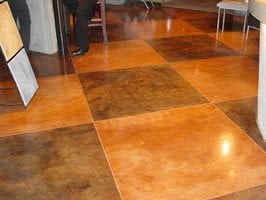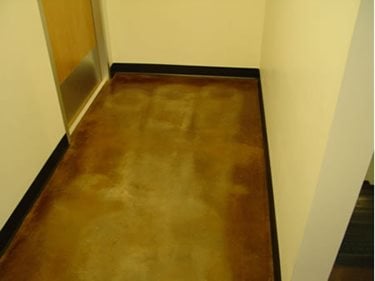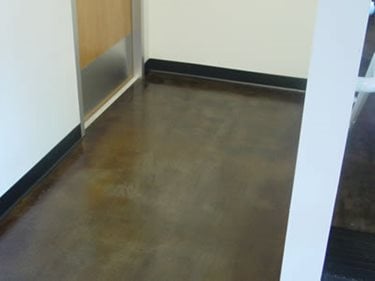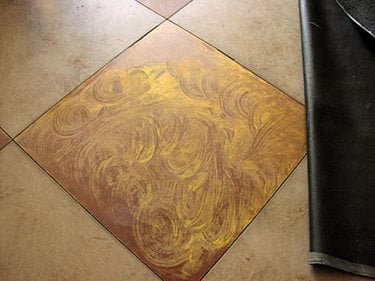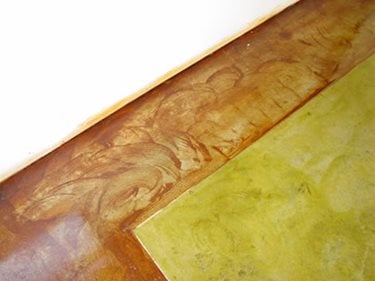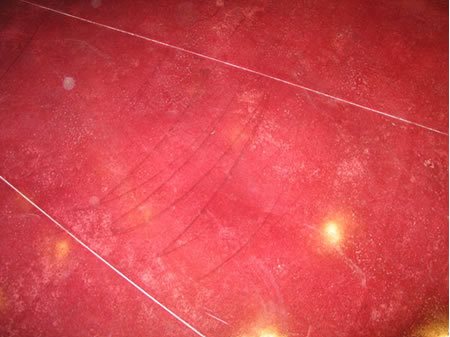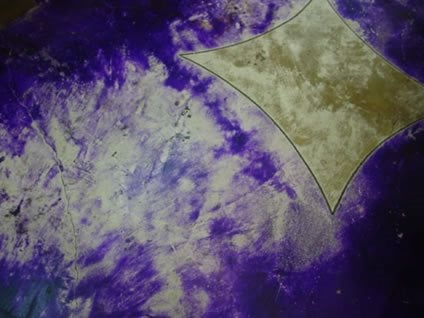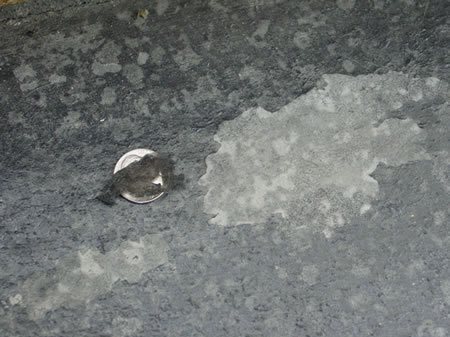- Stained Concrete Home
- Stained Concrete Pictures
- Sample Stain Colors
- Design Ideas for Stained Concrete
- Stained Concrete FAQs
- Pricing Stained Concrete
- Comparison Chart: Stained Concrete Versus Other Flooring Materials
- Stained Concrete How-To's
- Concrete Stain Application
- Sealing Stained Concrete
- Related Information:
- "Floor Me" Video Series
- Lea acerca de Cemento Manchado en Español
- Other Resources:
- Information About: Concrete Floors
- Find Products: Concrete Stains
- Design Ideas: Concrete Staining Info
Section Sponsor

Concrete Floor Stains
Troubleshooting Common Acid Stain Problems
Why They Occur and How to Fix ThemThe practice of staining concrete comprises unequal parts of science, process engineering, and art, loosely tied together with a bit of the unknown. Throw in multiple environmental factors, and the common result becomes unpredictability and color variation! Not surprisingly, these two factors (unpredictability and color variation) are what create the stunning effects that have made, and continue to make, staining so popular. Also, not a surprise, these same factors, along with the infinite combination of concrete surface conditions -- temperature, moisture, application methods, and sealer systems -- create more questions and problems than in any other decorative concrete discipline.
|
Staining Problems and Solutions Before, During and After Acid Staining BEFORE
DURING
AFTER
|
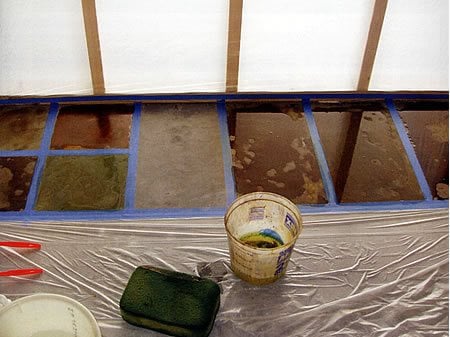
Prepare on site samples for your clients. Theyre the cheapest form of insurance you can buy prior to doing a stained project. Photo Courtesy of Bob Harris Guide to Staining Concrete Interior Floors.
Take heart! When you consider that problem projects make up far less than 1% of the millions of square feet of concrete stained each year, the good far outweighs the bad. Also, consider that the last five years have seen an unprecedented increase in quality literature -- books, web sites, videos, and material systems to help applicators, architects, and homeowners understand the process and products. For example, look at the resources ConcreteNetwork.com can offer both experienced and novice staining professionals. Unfortunately, even staining specialists with years of experience have problems from time to time. Avoiding problems or solving them quickly and with confidence is what this article is all about.
Stain related problems present themselves in many ways, and at any time. The following examples highlight the most common problems and fixes, since it would be virtually impossible to cover every issue concrete stain installers encounter. For better clarity I divide troubleshooting stained concrete into three simple categories: before, during, and after. The first of these common problems, and coincidentally the one most often neglected, takes place before the job begins or the contract is signed.
Before Staining
Remember the Seven Steps to Success Before You Start? (First in this series of articles.) Among the seven steps, the following three should be mandatory for anyone even contemplating staining as a profession. Step 1) Understand the Process and Products, Step 2) Expectation Management, andStep 4) Sampling! Since the process of staining results in such unpredictable and variegated tones and colors, not properly selling and preparing your clients is equivalent to project suicide. Providing in-depth information, insisting on signed contracts, and performing realistic jobsite samples (on every project) is cheap insurance in what can sometimes be a high stakes game of collecting your hard earned money. Special note: Since every piece of concrete is different, the only way to determine the true color and effect is by sampling on the floor to be stained. The response I have been staining for years or Ive never seen this before! does not hold any water when a color problem arises that could have been avoided by a job site sample!
The other part of troubleshooting before staining deals with surface effects. Also known as character marks, this is a catch all for a wide range of issues, man made and natural, that can play havoc with stained concrete. Some of these are virtually invisible on gray concrete, but once stained can stand out enough to ruin an otherwise beautiful stain job. Paint, cutting oil, chalk lines, curing compounds, sealers, tape residue, patching materials, burnished finish, and inconsistent cure to name a few, round out the most common surface issues that effect stain performance. The good news is that many of the above-mentioned issues can be detected prior to staining with a simple water test. By applying water to the concrete surface you can learn a lot about how stain will take, and if any additional surface preparation is required. Stains are 95% water, so if water beads up on the surface, chances are stain will do the same. Water may also bring out hidden surface issues allowing for additional surface preparation before you waste a lot of your time, money and material.
If you identify that the concrete has surface issues, the next move is figuring out what they are, and what type of measures are needed to eliminate them. Depending on the extent of the problem and the desires and budget of the client, corrective measures can include concrete degreasers, strippers, cleaners, surface sanding, and thin section micro-topping overlays. As with any corrective measure, testing in an inconspicuous area is always recommended prior to doing large-scale work. If a character mark happens to sneak by the water test and becomes apparent once the stain is down, using tinted sealers is a proven method for hiding these blemishes. Gaye GoodmansTips and Tricks section of her guide to acid staining covers this type of troubleshooting and touch up work in detail.
During Staining
The most common problems and fixes with the second category, during staining, deal primarily with the applicator (both person and equipment) and application methods. Either too much or not enough stain applied to the concrete can produce variable and sometimes unattractive results. Too little stain can produce blotchy and streaky results, often exaggerated by the brushes used to work the stain into the concrete.
This effect is rather easily remedied by additional applications of stain, or targeting the correct coverage rate during initial applications. Just as not enough stain can cause problems, over application can also be problematic. Contrary to common perception, applying heavy coats of stain will not always provide better color development. Not only does this waste product and increase clean up, but it can retard the ability of the stain to penetrate and react. We see this more often with the darker colors of stain, as well as some stains that are marketed as concentrates.
The problems of over application can also be magnified if the concrete in question is very dense and tightly finished. But surface density and color development shouldnt be an issue, because the water test and sampling process identified that before you even started, right? Unfortunately for many stain applicators, they realize they have an over application or density issue when most or all the color comes off in the neutralizing and cleaning process. At this time, the fix is obvious, and costly. Go back, properly prepare the surface and/or apply the stain in accordance with proper coverage rates.
Types of tools used to apply stain are the last of the common during application problems. Mops, rollers and squeegees are never a good method of stain application. The high concentration of stain coming off the ends of these types of applicators tend to leave roller marks or rows of color. Depending on the intensity of the color rows, proven fixes for these types of issues include dry sanding, acid washing or additional stain applications - sometimes with a slightly darker color of stain.
I want to stress the point that if at any time you have doubts about how the stain looks during or after application, DONT seal the surface. It is far easier to troubleshoot and repair stained concrete surfaces before they are sealed rather than afterwards.
After Staining
Most issues with stained concrete that occur after application revolve around sealer failure or lack of sealer maintenance. Too much stain residue remaining on the surface when sealing is the most common cause of sealer failure on stained concrete floors. These residues are highly acidic, which can chemically alter the sealer film as well as act as a bond breaker by clogging the pores of the concrete. This is why neutralization and removal of stain residue from the concrete surface is such an important step in staining. If significant amounts of color can be seen on pieces of the failing sealer, chances are that excess residue is the cause of the failure. Stripping the sealer, neutralizing and cleaning the floor, (sometimes re-staining) and then re-sealing are the common fixes for this avoidable, but all too common problem.
The other common post application problem with stained concrete is lack of maintenance. An otherwise beautifully stained floor with noticeable traffic patterns from lack of maintenance is the leading cause of perceived stain failure. I know of some respected applicators that will no longer apply stain to high traffic floors (bars, restaurants, office buildings) because lack of maintenance gives their work a bad name.
Not every concrete floor is a good candidate for stain. We as an industry have to start doing a better job of managing clients expectations regarding sealer maintenance. In particular, start offering maintenance programs, or at a minimum informing clients of what to expect weeks, months and years down the road. Stained concrete is not maintenance free! Be wary of those stain systems that recommend a few coats of cure and seal as the long-term sealer system. I encourage you to use those that include sacrificial maintenance top coatings and long-term maintenance programs as part of the overall program. Educating owners, architects, and designers should become an integral part of everyones staining process. On a positive note, even some badly worn stained floors can be brought back to life with the application of maintenance coatings. Many times it is not too late to begin a maintenance program. This speaks volumes to the strength and permanent nature of acid stains on concrete.
I encourage everyone staining concrete for a living to become an expert! Utilize the wide range of resources, reputable schools and good training aids available to todays staining professional. Educate yourself and your clients on what to expect before, during, and after stain is applied. Developing your own troubleshooting techniques in conjunction with these proven solutions will help minimize future staining headaches.
Chris Sullivan writes feature articles for The Concrete Network. He is vice president of sales and marketing for ChemSystems Inc. (a Houston-based manufacturer of architectural concrete products).
